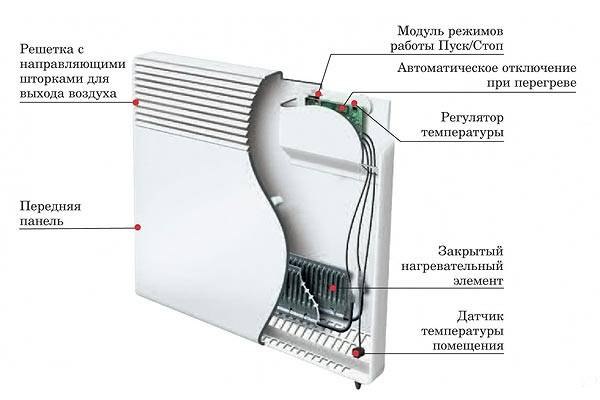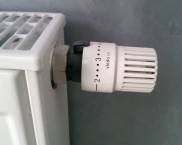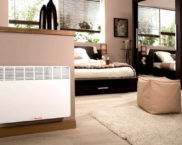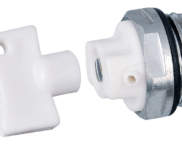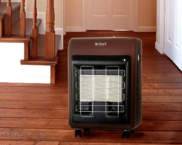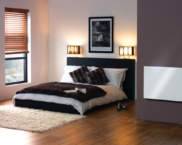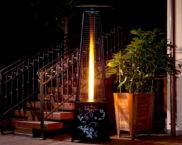Wall mounted electric heating convectors with thermostat
HWall electric heating convectors with a thermostat are used for efficient heating of living and working premises by natural convection. The use of devices of this type is justified:
- as an alternative to central or local heating from other sources;
- to create an optimal indoor climate;
- as an autonomous heating complex for rooms, the equipment of which with other types of heating elements is impractical (verandas, covered terraces, balconies And so on);
- for heating summer cottages, garages and other buildings or individual rooms that do not require constant heating.
The content of the article
- 1 Video: which electric convector is better to choose
- 2 The principle of operation and safety during use
- 3 Varieties and classification of construction types
- 4 5 main points to pay attention to when choosing a convector
- 5 Fast heating with a minimum of disadvantages
- 6 Video review of electric convectors with thermostat
Video: which electric convector is better to choose
The principle of operation and safety during use
Electric convectors heat the room due to the natural circulation of air, caused by the rise of hot masses upward with the displacement of cold ones to the floor. Thus, a constant heat turnover is created, contributing to the rapid heating of the room.
An increase in temperature occurs when air passes through the convector due to the absorption of heat from the heating element. The advantages of the device include:
- high design efficiency and uniformity of heat distribution. Having spent 1 kW of electricity, the consumer receives almost the same amount of heat energy;
- compact body size and ease of installation;
- the ability to maintain a constant temperature due to the presence thermostatic relay;
- economical power consumption;
- possibility of installation in rooms with high humidity;
- relatively low temperature of the convector body, especially in comparison with other types of heating devices;
- lack of oxygen burnout effect;
- long term of use even in the scenario of continuous operation;
- noiseless heating.
The simplicity of the design of wall-mounted electric convectors and the presence thermal relay - a guarantee of ease of use and low safety requirements. When installing, it is enough to make sure that the wire goes to outlet without tension. During operation, the only precaution is to maintain conditions for the natural movement of air through the body of the device.
Regardless of the model and brand of the convector, manufacturers cover products with a paint and varnish composition that is resistant to mechanical damage, temperature extremes and fire.
Varieties and classification of construction types
The vast majority of wall-mounted electric heating convectors with a thermostat on the market are equipped with monolithic heating elements. There are many designs of heaters and diffusers. The basic principle remains the creation of a ribbed surface that makes it easier for the passing air to absorb heat.
Thermostats are the key to economical operation and maintaining a constant temperature. According to the principle of operation, they are divided into mechanical and electronic.
Convectors with a mechanical type thermostat are cheaper than similar ones controlled by electronics. They are more reliable, but at the same time respond to temperature changes longer.
Devices with an electronic thermostat are often completed with:
- an additional module with which the user can program the temperature based on the time of day;
- remote control system;
- complex of integration into the "smart home".
Depending on the availability of additional functions, the cost of the parting increases proportionally.
5 main points to pay attention to when choosing a convector
Choosing wall-mounted electric heating convectors with a thermostat:
- decide on the volume of the room in which it will be installed. For rooms of a standard form, it is enough to measure the length, width and height of the room and multiply the numbers obtained. The main rule of calculation is that the power of the device should be at least 10 kW per 10 m³ of the room, with a normal ceiling height of 2.7 m. twice;
- if you plan to use the appliance in a house with an old wiring or a summer cottage with an unstable power supply, your choice is a device equipped with a mechanical thermostat;
- remember that the recommended wiring diagram for the convector is in a separate line from the switchboard with an automatic fuse. Make sure that there is sufficient wire length and section corresponding to the power of the device;
- the optimal height of the device, which guarantees fast and uniform heating of the air, is 40-50 cm. The width of the device directly depends on the potentially heated area;
- many modern devices are supplied in a universal package, including the possibility of floor mounting. If you foresee the need to heat different rooms, this makes it possible to save on the purchase of another stationary device.
Fast heating with a minimum of disadvantages
Wall-mounted electric convectors with a thermostat are an effective and relatively inexpensive way to establish heating or improve the indoor climate. A wide selection of designs, operating capacities, types of thermoregulation, shapes and design solutions from Russian, European and Chinese manufacturers will allow you to choose the optimal solution for any needs and budget.
A significant drawback of this type of heating is the cost of electricity. However, it is also solved by purchasing top-end models equipped with flexible means of setting and controlling energy consumption.
Video review of electric convectors with thermostat





